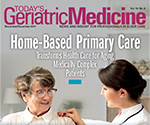 |
Although specialized hospice interdisciplinary teams are ideally equipped to provide supportive care to patients at the end of life and their families, hospice care often is overlooked or dismissed when patients could benefit from its unique services. The very short periods of such care at the end of life indicate the need to expand outreach to patients and families, educating them on the solutions and associated comforts available.
In addition to reading our e-newsletter, be sure to visit Today’s Geriatric Medicine’s website at www.TodaysGeriatricMedicine.com, where you’ll find news and information that’s relevant and reliable. We welcome your feedback at TGMeditor@gvpub.com. Follow Today’s Geriatric Medicine on Facebook and Twitter, too.
— Barbara Worthington, editor |
 |
 |
NHPCO Releases ‘Facts and Figures: Hospice Care in America’
The National Hospice and Palliative Care Organization (NHPCO) continues to be concerned about the number of people who benefit from the care and services that hospices provide for a short period of time. NHPCO’s newly issued report, “Facts and Figures: Hospice Care in America,” indicates that just over 40% of Medicare beneficiaries accessing hospice received care for 14 days or fewer in 2015.
“The hospice interdisciplinary team is ideally suited to provide care and support to patients and family caregivers throughout the last months of life, not just the last days,” says Edo Banach, NHPCO president and CEO.
“We need to continue reaching out to patients, family caregivers, and other health care professionals to help them understand all the benefits that hospice care brings, particularly when provided in a timely fashion as part of a continuum of care,” Banach adds.
Full story » |
 |
 |
Opioid Use in Older Adults: Care or Crisis?
Effective evaluation and management of chronic pain in the vulnerable older adult population requires person-centered care. Comfort and quality of life are of paramount importance. Read more »
Nutrition-Focused Physical Exam: The Micronutrient Deficiency Detective
Identifying and treating older adults' nutrient deficiencies is essential to ensuring optimal quality of life. Read more »
Unmasking Overactive Bladder
Physicians can create a dialogue with patients to identify an embarrassing problem. Read more » |
 |
|
|
 |
|
|
 |
 |
Lower Cost OTC Hearing Aids
Will Reach More People,
Prevent Other Medical Problems
New federal legislation will allow people with mild to moderate hearing loss to purchase hearing aids over the counter from retailers rather than through audiologists, saving older adults thousands of dollars, according to an article in The Baltimore Sun.
Opioid Prescription Study Challenges Government Guidelines for 7-Day Limit
A recent study described in The Washington Times notes that the restrictive opioid prescribing limitation recommended by the Centers for Disease Control and Prevention can be inadequate in addressing patients' acute pain.
The Staggering Prices
of Long Term Care 2017
Steadily increasing long term care costs are likely to soon exceed $100,000 per year for a private nursing home room, according to an article at Next Avenue online.
Social Security Giveth,
Medical Costs Taketh Away
According to an article at Kaiser Health News online, after 2018, Medicare beneficiaries’ medical costs are expected to outpace the increase in Social Security benefits. |
 |
|
